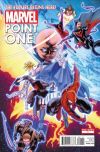|
|
 |
It didn’t. In any capacity.
Why? Because there is no history, just introductions to five new series told with a flimsy framing device. This is, and make no mistake, an advertisement anthology and, as such, is spotty in quality and frustrating in content. And the worst part, it leaves me more confused than anything else. For example, David Lapham’s story promoting his Age of Apocalypse series stars a man named Krakken. Perfect. Krakken: big black guy who kind of looks like Ultimate Nick Fury with the patch on the wrong eye. Wait, I don’t know who that is or why he’s getting attacked by William Stryker, whom I only know because I used to read Chris Yost and Craig Kyle’s New X-Men, and their X-Force series before it became a crossover book that made no sense on its own. The story assumes a continuity I don’t know that makes it difficult to follow and, in my extremely humble opinion, completely against the point of the book. Jeph Loeb’s Harbringer is a little better. Still in media res, as it were, but at least it sets something up for future reading, but still doesn’t answer any questions about what exactly was going on. Oh, and the fact the whole thing comes off as a Green Lantern Corps. clone, complete with Darkseid-looking villain and something called the Nova Corps. doesn’t really sell me on it. I’d rather read Green Lantern if I had any semblance of interest, which I don’t. Easily the
 |
The artwork, however, is almost universally good. From the classic Kirby-esque work of Javier Pulido to the rougher beauty of Roberto de la Torre (my favourite of the book) and the familiarity of Bryan Hitch and Salvador Larroca, the book looks better than what it sounds like. Opening with Pulido in a story about the Watcher is an obviously good choice, tapping readers into Marvel Comics heyday in the sixties visually before presenting much more contemporary art, it brings a historicity to a book that otherwise doesn’t offer any. I simply adored de la Torre’s work, it’s roughness and heavy inking was moody and gritty in all the right ways. Old veterans and popular artists certainly put their best in as well, it’s all quite nice to look at and I even appreciated Hitch’s full page of shakiness, making the page almost reflect a sort of reality cam/ Children of Men aesthetic. While the book can’t survive on its own (even though this could be a decent contender), this point one is nice to look at. If only there wasn’t all those balloons in the way.
Grade: C Betraying the point while looking really good doing it.
© Copyright 2002-2019 by Toon Doctor Inc. - All rights Reserved. All other texts, images, characters and trademarks are copyright their respective owners. Use of material in this document (including reproduction, modification, distribution, electronic transmission or republication) without prior written permission is strictly prohibited.

